 Credit risk is a crucial financial consideration for companies of all shapes and sizes. Organizations aren't going to thrive if they can't rely on customers to pay what they owe, can't depend on their supply chain to move materials and components in a timely manner, or fear for the stability of their banking partners.
Credit risk is a crucial financial consideration for companies of all shapes and sizes. Organizations aren't going to thrive if they can't rely on customers to pay what they owe, can't depend on their supply chain to move materials and components in a timely manner, or fear for the stability of their banking partners.
It's a timeless topic, but with many new wrinkles, as today's technology tools make a world of information and powerful analytics capabilities available to credit managers. To learn more about how companies today are managing the myriad credit risks they face—and to identify opportunities for improvement—Treasury & Risk undertook the “2016 Credit Risk Management Survey,” sponsored by Moody's Analytics.
Conducted this summer, the survey received responses from 110 professionals who work in treasury (43 percent), finance (40 percent), risk management (10 percent), or line-of business management (6 percent). They hail from businesses of all sizes, across a wide swath of industries.
Complete your profile to continue reading and get FREE access to Treasury & Risk, part of your ALM digital membership.
Your access to unlimited Treasury & Risk content isn’t changing.
Once you are an ALM digital member, you’ll receive:
- Thought leadership on regulatory changes, economic trends, corporate success stories, and tactical solutions for treasurers, CFOs, risk managers, controllers, and other finance professionals
- Informative weekly newsletter featuring news, analysis, real-world case studies, and other critical content
- Educational webcasts, white papers, and ebooks from industry thought leaders
- Critical coverage of the employee benefits and financial advisory markets on our other ALM sites, PropertyCasualty360 and ThinkAdvisor
Already have an account? Sign In Now
*May exclude premium content© 2025 ALM Global, LLC, All Rights Reserved. Request academic re-use from www.copyright.com. All other uses, submit a request to [email protected]. For more information visit Asset & Logo Licensing.





